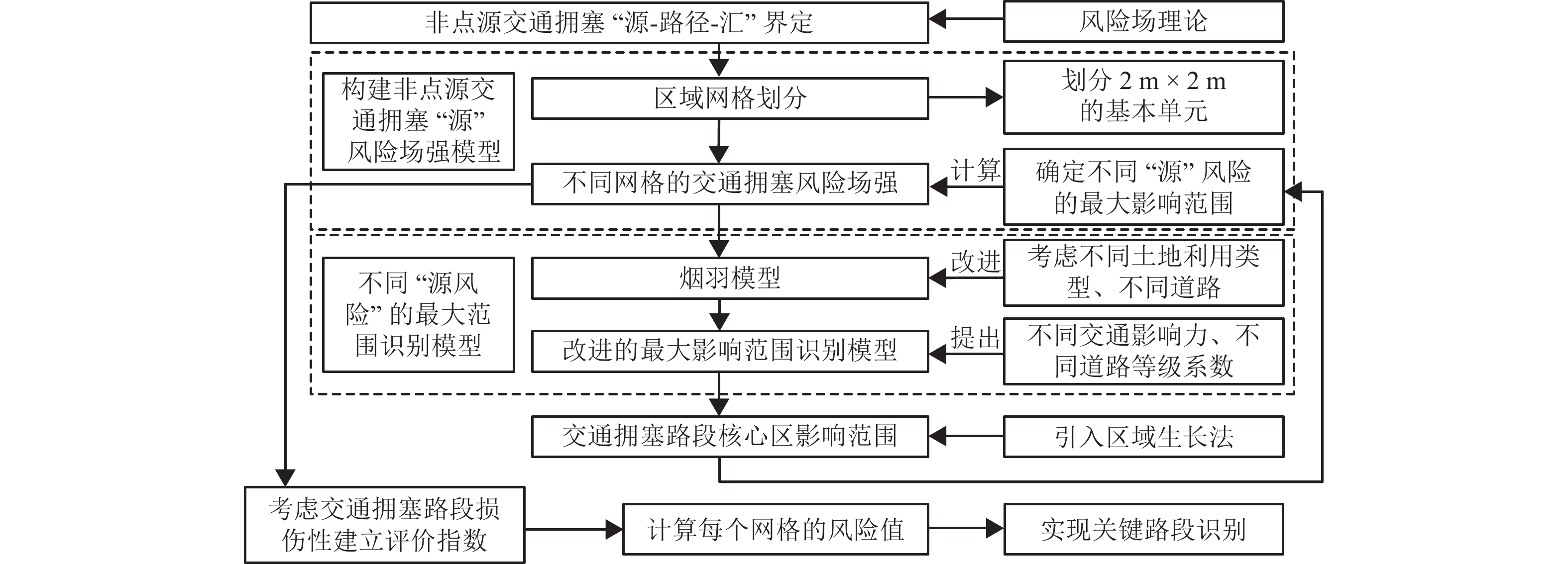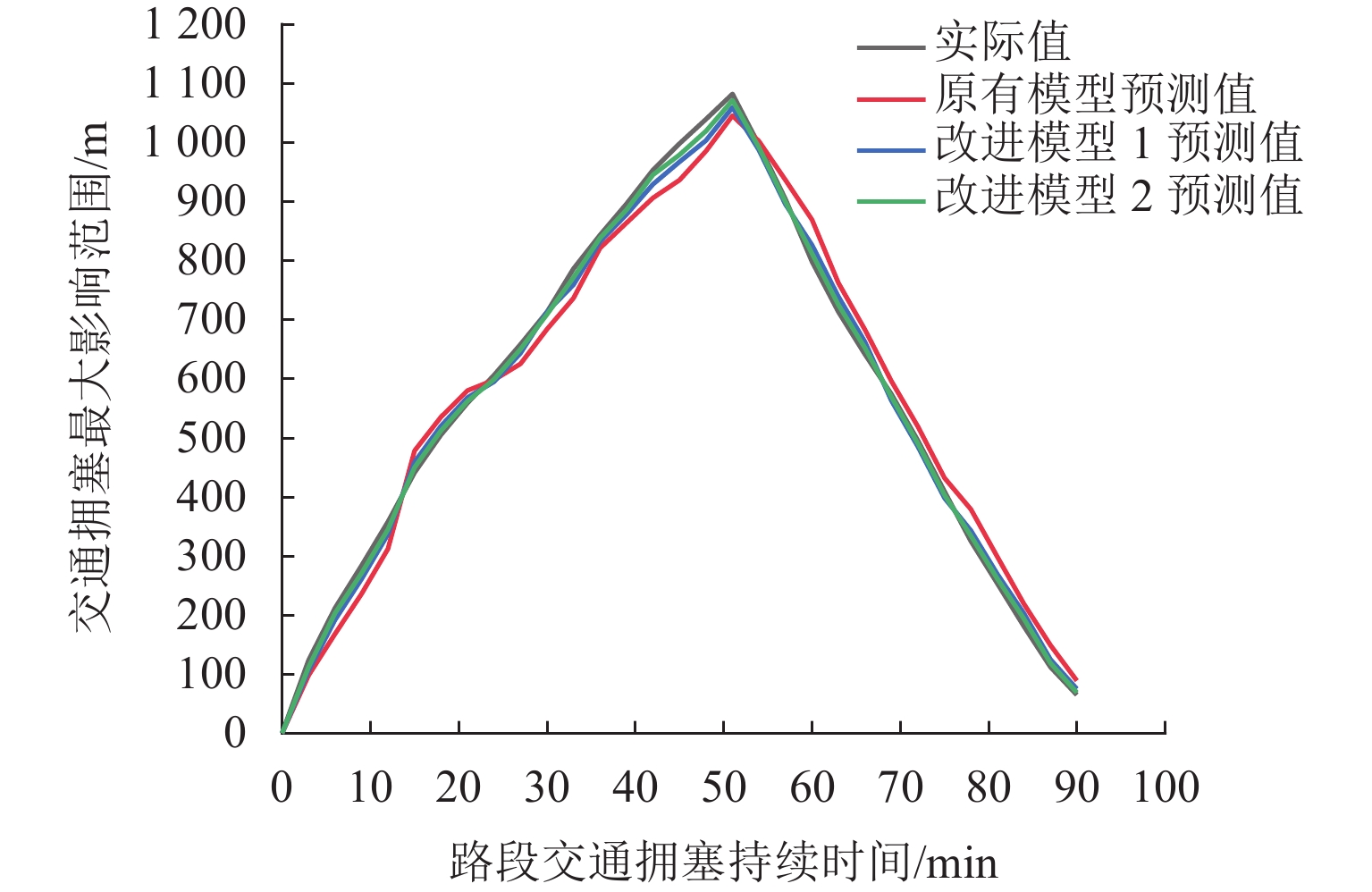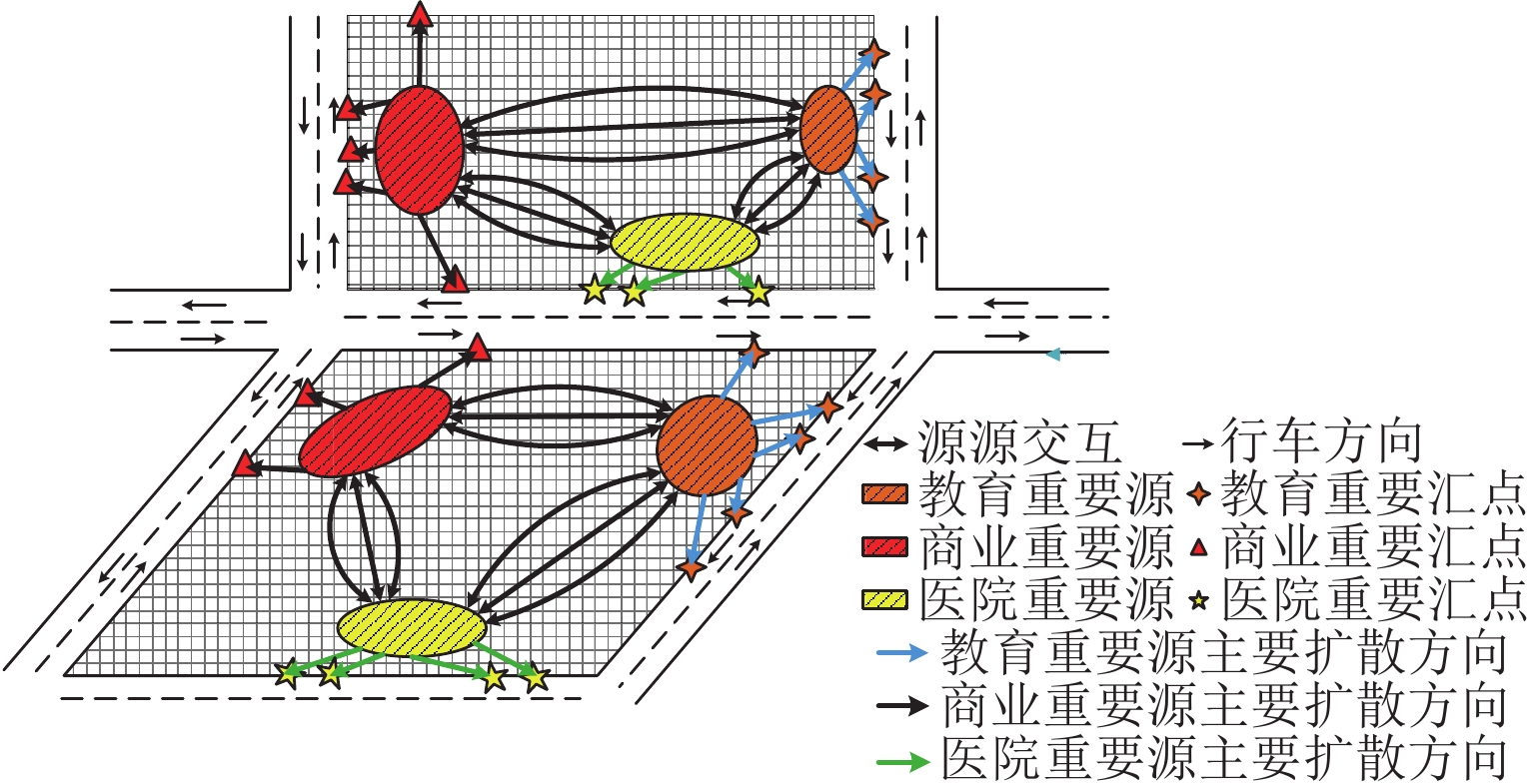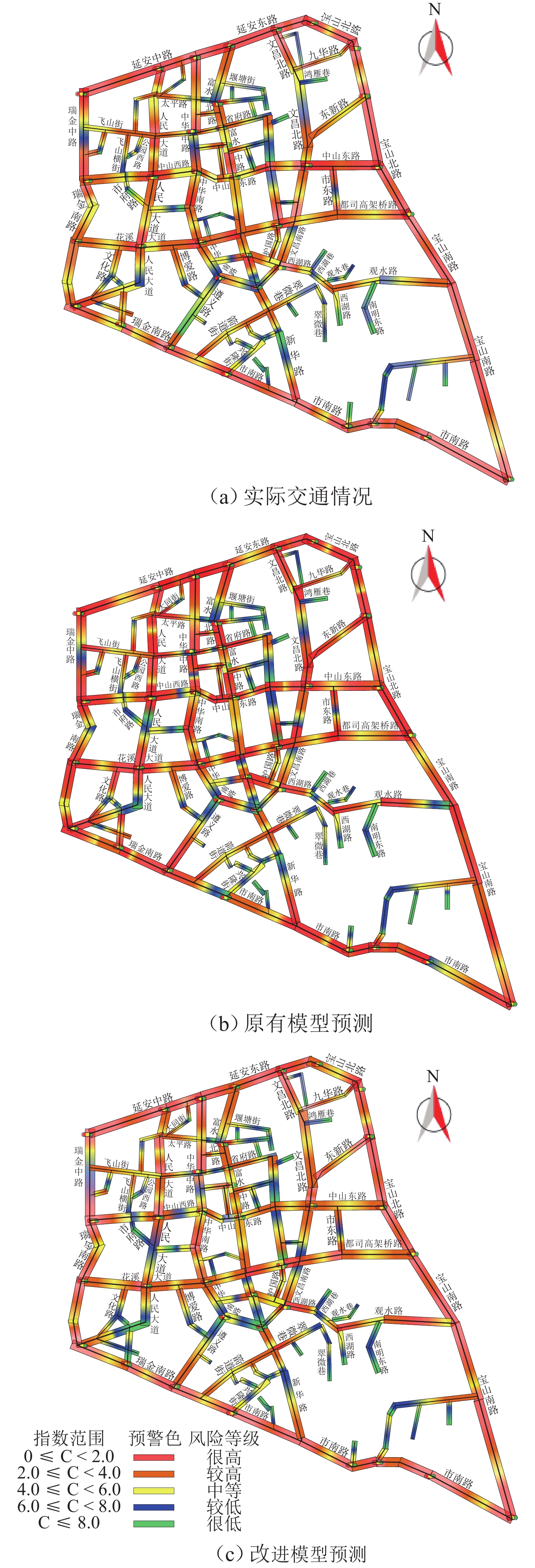Determination of Influence Range of Urban Traffic Congestion and Identification of Key Road Sections
-
摘要:
为研究非点源交通拥塞的影响范围及关键路段识别,引入风险场强理论、区域生长法对烟羽模型进行适应性改进,以确定最大、核心影响范围及识别关键路段. 首先,对非点源交通拥塞的“源-路径-汇”进行界定,以2021年贵阳市的交通调查数据、交通状态数据等为基础,构建非点源交通拥塞的“源”风险场强模型;考虑不同土地利用性质的交通影响力及不同道路等级调整系数并进行标定,建立基于不同“源”风险的最大影响范围识别模型,引入区域生长法建立路段核心区影响范围确定模型;最后,以路段交通量、长度、时间构建交通拥塞路段损伤性评价指数并对交通拥塞程度进行定量化研究,对原有模型、改进模型及实际情况进行对比分析. 结果表明:不同土地利用性质和不同道路等级对路段交通拥塞影响程度不同;改进后的不同“源”风险影响范围识别模型有效性较强,且预测精度提高3.54%,更接近实际情况;考虑区域生长法的路段交通拥塞核心区影响范围准确性更高,与实际情况仅相差2.66%. 综上所述,本研究为城市非点源交通拥塞累积性风险区范围划定和风险关键路径确定提供一种新的思路,对进一步开展不同交通拥塞发生类型的治理提供理论依据.
Abstract:In order to determine the influence range of non-point source traffic congestion and identify key road sections, the risk field strength theory and the regional growth method were introduced to improve the plume model. The maximum and core influence ranges were determined, and key road sections were identified. First, the “source-path-sink” of non-point source traffic congestion was defined, and the “source” risk field strength model of non-point source traffic congestion was constructed based on the traffic survey data and traffic status data in Guiyang in 2021. By considering the traffic influence of different land use properties and the adjustment coefficient of different road grades for calibration, the identification model of the maximum influence range was established based on different “source” risks, and the regional growth method was introduced to establish a model for determining the influence range of the core area of the road section. Finally, based on the traffic volume, length, and time of the road section, the damage evaluation index of the road section with traffic congestion was constructed, and quantitative research on the degree of traffic congestion was carried out. The original model, the improved model, and the actual situation were compared. The results show that different land use properties and different road grades have different influences on traffic congestion in road sections. The improved identification model of influence range based on different “source” risks is more effective, and the prediction accuracy is increased by 3.54%, which is closer to the actual situation. With the regional growth method, the accuracy of the influence range of the core area of the road section with traffic congestion is higher, which is 2.66% different from the actual situation. In summary, a new idea for the delineation of the cumulative risk range of urban non-point source traffic congestion and the determination of key risk paths is provided, also serving as a theoretical basis for further governance of different types of traffic congestion.
-
Key words:
- traffic engineering /
- regional growth method /
- risk evaluation /
- traffic congestion /
- damage
-
随着城市的不断更新,城市交通量呈现“点多、线宽、面广”的短时集聚效应,促使交通治理能力不断提升,且城市道路网络的点源交通拥塞得到有效控制. 但突发性非点源交通对城市交通拥塞的影响显著提升,造成城市路网二次拥塞现象严重. 非点源交通拥塞普遍具有可变性、突发性、影响范围广泛性等特点,因此,有效识别非点源交通拥塞的影响范围、确定关键路段,可以提升城市交通拥塞疏导效果,合理控制城市交通拥塞的蔓延范围.
国内外学者对城市交通拥堵判别、风险传播进行了研究. 在交通拥堵判别方面,多集中于关键因素、评价指标等,Jiang等[1]结合不确定性路网信息和交通流参数序列对城市交通拥堵交叉口和路段进行预测;Wu等[2]对交通拥堵指数进行多尺度和递推分析,得出交通拥堵指数在长期交通状态预测中具有重要作用;Noor等[3]对造成中央商务区 (CBD)交通拥堵因素展开分析,并对交通拥堵状况进行评估. 也有学者宏观分析交通拥堵成因、时空传播末端等,Luan等[4]利用动态贝叶斯图卷积网络对城市交通拥堵传播时空范围和模式进行分析;Wang等[5]利用面板数据分析土地利用性质、城市形态和交通拥堵三者之间的关系;黄建华等[6]考虑拥堵预警信息、出行者等多重信息构建改进的多重网络拥堵风险传播模型;王忠宇等[7]以复合饱和度、流量比最小等为优化目标,基于网络变结构对城市交通拥堵进行优化;陈美林等[8]基于出租车GPS数据确定网格关联置信度及交通拥堵传播强度,并分析拥堵传播规律. 综上所述,交通拥塞的关键路段识别及分区控制已成为研究热点,但目前的研究大多针对点源交通拥塞,对非点源交通拥塞风险区的研究较少,对非点源交通拥塞关键路段识别的研究则更少.
环境风险场评估方法主要用于水污染风险[9],区域生长法主要用于图像识别处理等[10],且模型具有较好的适应性和可靠性等特点. 因此,本文以贵阳市部分区域作为研究区域,将环境风险场强理论应用于城市交通拥塞研究,考虑非点源交通的不同拥塞源、拥塞迁移路径、拥塞状态3个方面要素,将高斯烟羽模型引入风险场强影响范围识别中. 在考虑不同土地利用性质及不同道路等级的基础上对城市交通非点源交通拥塞范围识别模型进行修正,并引入区域生长法对交通拥塞路段的核心影响范围进行确定,以构建交通拥塞路段损伤性评价指标体系,综合构建交通拥塞综合评价指数. 通过对原有模型、改进模型及实际情况进行对比分析,实现非点源交通拥塞的损伤性综合评价,建立非点源交通拥塞路段不同“源”风险的关键路段识别及损伤性综合评价模型,为交通拥塞治理提供新的参考.
1. 研究区概况
本文用贵阳市主城区内的交通数据对城市非点源交通拥塞风险场影响范围及关键路段识别问题进行研究. 基于OSM (open service mesh)开源获取的城市路网矢量数据,为研究不同“源”对“汇”的影响,将研究区域内等源点集聚效应强的医院、公园、学校、大型商业区(中心)、行政办公等考虑在内. 将以延安中路、延安东路、宝山北路、市南路、瑞金南路、瑞金中路围合约4.5 km2作为研究区域,其原始路网结构如图1所示.
选取研究区域2021年6月份的非点源交通数据,主要利用Python进行爬取,包括交通量、运行速度、车道数、行程时间等,并对其进行整理,研究区域范围内的道路基本情况如表1所示. 对非点源交通的“源”进行不同划分,明确不同“源风险”下的“汇格局”特征,从而实现精准识别关键路段,并通过控制交通拥塞路段风险损伤能力提升路网运行效率.
表 1 研究区域内高峰小时道路基本情况Table 1. Basic conditions of roads during peak hours in study area编号 道路名称 道路等级 车道数 交通量/
(辆·h−1)通行能力/
(辆·h−1)饱和度 平均行车速度/
(km·h−1)1 延安中路 主干路 双向 8 车道 3208 3718 0.863 29.87 2 延安东路 主干路 双向 8 车道 3250 3718 0.874 29.35 3 宝山北路 城市快速路 双向 8 车道 + 潮汐车道 3995 4837 0.826 41.23 4 宝山南路 城市快速路 双向 8 车道 + 潮汐车道 4019 4837 0.831 40.85 5 市南路 城市快速路 双向 8 车道 3902 4375 0.892 42.31 6 瑞金中路 主干路 双向 6 车道 2670 2990 0.893 28.06 7 瑞金南路 主干路 双向 6 车道 2727 2990 0.912 27.86 8 人民大道 主干路 双向 6 车道 2637 2990 0.882 28.15 9 中山西路 主干路 双向 6 车道 2450 2990 0.836 29.86 10 中山东路 主干路 双向 6 车道 2448 2990 0.819 30.34 11 中华中路 主干路 双向 8 车道 3093 3718 0.832 28.36 12 中华南路 主干路 双向 8 车道 3142 3718 0.845 29.12 13 富水北路 支路 单向 4 车道 1547 1673 0.925 25.36 14 富水中路 主路 单向 3 车道 1218 1345 0.906 23.98 15 遵义路 次干路 双向 6 车道 1708 2055 0.831 29.26 16 新华路 次干路 双向 6 车道 1662 2055 0.809 28.75 17 西湖路 次干路 双向 4 车道 1200 1455 0.825 27.56 18 博爱路 支路 双向 2 车道 452 504 0.897 20.28 19 文化路 支路 双向 2 车道 448 504 0.889 19.32 20 观水路 次干路 双向 4 车道 1312 1455 0.902 28.14 21 南明南路 支路 双向 2 车道 431 504 0.856 18.97 22 都司高架桥路 主干路 双向 6 车道 2676 2990 0.895 29.43 2. 非点源交通拥塞风险场最大影响范围确定及关键路段识别模型
非点源交通与突发性交通拥塞有较大不同,主要表现为累积性,前者是多种因素相互作用产生的累积性道路损伤的重要表现. 累积性交通拥塞源风险种类多样,易受连接道路网等关键节点扰动,造成时空范围分布较广等复杂累积性影响. 关键源风险对区域交通拥塞有重要的影响,治理关键源可以有效降低交通拥塞风险. 以关键源风险划定非点源交通拥塞区治理范围,非点源交通拥塞发生过程中,交通拥塞风险和交通流随道路网进行迁移,且呈现道路渔网状结构进行流动. 因此,为判断非点源交通拥塞的重要“源”,将不同土地开发强度考虑在内,结合城市不同道路网等级对非点源交通拥塞进行治理,并识别探讨迁移路径,研究路线如图2所示.
2.1 非点源交通拥塞“源-路径-汇”界定
将风险场理论引入城市非点源交通拥塞研究中,非点源交通拥塞包括交通拥塞源、交通拥塞扩散路径、交通拥塞汇点. 交通拥塞源指在一定时间、范围内打破原来自适应交通系统的固有平衡性,使得交通量在短时间有限空间范围内进行集聚及扩散,导致车辆无法以正常速度行驶,造成交通拥塞的交通源. 交通拥塞源主要有3类:医院重要源、商业重要源、教育重要源. 交通拥塞扩散路径指在交通拥塞源的基础上,发生突发性交通量,通过固有道路网实现交通拥塞扩散的物理交通流线. 交通拥塞汇点指交通拥塞源通过交通拥塞扩散路径最终在城市道路网上进行合流迁移的具体物理点. 不同土地利用性质的“源-路径-汇”风险示意如图3所示.
交通拥塞的扩散和对城市道路网络的影响时间、大小可以通过交通拥塞场的影响范围进行确定,城市道路网络对非点源交通拥塞的损伤性可以通过道路网络的评价指标进行综合评估. 城市道路网络中任意网格(x,y)的交通拥塞风险不同,主要由该物理点的交通拥塞场强、城市道路网络的损伤性进行确定. 因此,某一城市道路交通中网格(x,y)在时间z的交通拥塞风险Rx,y,z为
Rx,y,z=f(Ex,y,z,Vx,y,z), (1) 式中:Ex,y,z为时间z网格(x,y)的风险场强;Vx,y,z为时间z网格(x,y)的城市道路网络损伤性.
2.2 构建非点源交通拥塞“源”风险场强模型
2.2.1 研究区域网格划分
本研究采用基于OSM获取的城市路网矢量数据,进一步对城市交通拥塞进行有效研究,在ArcGis中考虑城市道路网络布局,并对研究区域进行物理网格划分,以2 m × 2 m的网格为基本单元,共将研究区域划分为
11268 个网格.2.2.2 计算不同网格的交通拥塞风险场强
交通拥塞风险主要是通过城市道路网络、节点进行扩散,且“源”风险随着扩散路径物理空间距离的增加一般呈线性递减的趋势,为方便计算,将模型进行简化. 城市道路网络中的交通拥塞风险场强度计算式如(2)~(5)所示.
Ex,y,z=Hx,y,z+Sx,y,z+Gx,y,z, (2) Hx,y,z={a∑m=1Qm, 0⩽ml⩽2,a∑m=1(Qm−QmmlA), 2<ml⩽A,0,A<ml, (3) Sx,y,z={b∑j=1Qj, 0⩽jl⩽2,b∑j=1(Qj−QjjlB), 2<jl⩽B,0,B<jl (4) Gx,y,z={c∑k=1Qk, 0⩽kl⩽2,c∑k=1(Qk−QkklC), 2<kl⩽C, 0,C<kl, (5) 式中:Hx,y,z为网格(x,y)在时间z的医院用地交通拥塞“源”风险场强;Sx,y,z为网格(x,y)在时间z的商业用地交通拥塞“源”风险场强;Gx,y,z为网格(x,y)在z时间的教育用地交通拥塞“源”风险场强;Qm为第m个医院产生的交通发生当量;Qj为第j个商业(区)中心产生的交通发生当量;Qk为第k个学校产生的交通发生当量,交通发生当量指某个土地利用性质不同的区域产生的交通量除去吸引的交通量,用以表征不同土地利用性质单位时间内对城市路网交通的风险影响大小;a、b、c分别为城市道路网络中医院、商业(区)中心、学校的数量;ml、jl、kl分别为医院、商业(区)中心、学校的交通拥塞风险“源”与网格中心的距离;A、B、C分别为不同医院、商业(区)中心、学校的交通拥塞风险“源”的最大影响范围.
2.3 建立基于不同“源”风险的最大影响范围识别模型
由于交通具有自适应特性,通常交通流会从交通拥塞风险高的地方流向交通拥塞风险低的地方,即交通拥塞风险高的网格才会对交通拥塞风险低的网格造成影响.
为对不同的“源”风险影响范围进行确定,基础的烟羽模型,如式(6)所示.
D=q2πuσyσhexp(−y2d2σ2y){exp[−12(zk−h)2σ2h]+exp[−12(zk+h)2σ2h]}, (6) 式中:D为空间中点(xk, yk, zk)处的扩散气体浓度,q为毒气源释放速率,u为平均风速,yd、h分别为毒气源的横向平面坐标和垂直高度,σyd、σh分别为横向与垂直扩散参数.
本文对烟羽模型进行适应性改进,在城市道路网络中,交通拥塞“源”风险的扩散在二维物理道路结构网络中进行. 因此,将式(6)变形为
Dz=qz2πuzσzyexp(−y2z2σ2zy), (7) 式中:Dz为交通网格(x, y, z)的交通拥塞风险大小, yz分别为交通网格距“源”风险点的扩散方向的垂直距离,qz为“源”风险的交通拥塞大小,uz为交通拥塞“源”风险的平均行程车速,σzy为交通拥塞在垂直方向的扩散系数.
本文参考文献[11],将式(7)简化为
Xd=β3√ζpko√2πId, (8) 式中:Xd为最大扩散距离;β为调节参数,取1.00、0.30、0.05等值;ko为常量,ko∈(0.15,1.00);ζ为交通量扩散系数,ζ∈(0,1);p为位能;Id为区域不同土地利用性质的交通拥塞“源”风险路段的交通影响力.
对式(8)进行如下变形:
1) 结合不同土地利用类型,将区域内的交通影响力Id按照医院、商业、学校3个部分比例进行综合确定.
2) 不同交通网格的风险场强有明显不同. 位能p用时间z内的累积性交通量qw,z表示.
3) 交通拥塞“源”风险扩散的最主要路径与不同道路的设计等级有关,通过道路等级差异系数η进行调整,取1.0、0.8、0.7、0.5等值.
4) 城市道路网络中,路段的交通拥塞程度主要与路段的平均运行速度有关,因此,对模型进行调节,交通拥塞风险“源”相邻接的n个路段的风险场强迁移程度大小为1nn∑i=1vS,ivf,i,其中:vS,i为路段i的平均运行速度,vf,i为路段i的自由流车速.
不同交通拥塞“源”风险的最大影响范围模型为
Xmaxd=η3√ζqw,zko2√πId 1nn∑i=1vS,ivf,i. (9) 2.4 基于区域生长法的交通拥塞路段核心区影响范围确定
将区域生长法的思想引入交通拥塞路段“源”风险核心区影响范围模型,明确每个风险“源”的真实核心区影响范围,通过对全区域网格进行搜索,网格里面的数字代表不同网格(x,y)在时间z的历史累积交通拥塞程度的大小,交通拥塞的一般迁移规律总是从交通拥塞高的物理点到交通拥塞低的物理点. 本文利用ArcGis实现交通拥塞的全局搜索. 计算过程如下:
步骤1 假设不同土地利用性质的“源风险”的最大影响范围为Xmaxd,将风险源物理点作为交通拥塞风险的生长起点,将风险源物理点的交通拥塞大小值与周围的邻接点进行比较,并对风险源物理点进行合并;
步骤2 将步骤1中筛选的物理点作为下一个生长起点继续对邻接点进行搜索计算,对不同的物理点进行计算;
步骤3 直至没有下一个生长起点或者超过不同土地利用类型的最大影响范围Xmaxd为止. 至此,确定最终的核心影响范围. 某一“源”风险的核心影响范围确定如图4所示.
2.5 交通拥塞路段损伤性计算模型
交通拥塞风险路段损伤性Vw,x,y,z可以通过道路交通拥塞的长度、出行时间、实际交通量、平均行驶速度等综合反映. 根据反映交通拥塞的不同指标与自由流状态下的指标进行对比分析,并计算交通拥塞路段的易损性,具体如表2所示.
表 2 交通拥塞风险路段损伤性指数划分Table 2. Damage index classification of road sections with traffic congestion risk指标描述 关系表述 权重 分值 风险等级 代表色 实际交通量 qs 和自由流情况下交通量 qf 的关系 qs ≤ 0.3qf 1/3 20 很低 ● 绿色0.3qf < qs ≤ 0.6qf 40 较低 ● 蓝色0.6qf < qs ≤ 0.7qf 60 中等 ● 黄色0.7qf < qs ≤ 0.8qf 80 较高 ● 橙色0.8qf < qs ≤ 1.0qf 100 很高 ● 红色道路拥塞长度 lf 和道路实际长度 ls 的关系 lf ≤ 0.04ls 1/3 20 很低 ● 绿色0.04ls < lf ≤ 0.08ls 40 较低 ● 蓝色0.08ls < lf ≤ 0.12ls 60 中等 ● 黄色0.12ls < lf ≤ 0.15ls 80 较高 ● 橙色0.15ls < lf 100 很高 ● 红色实际出行时间 ts 和自由流情况下出行时间 tf 的关系 ts ≤ 0.3tf 1/3 20 很低 ● 绿色0.3tf < ts ≤ 0.5tf 40 较低 ● 蓝色0.5tf < ts ≤ 0.6tf 60 中等 ● 黄色0.6tf < ts ≤ 0.7tf 80 较高 ● 橙色0.7tf < ts ≤ 1.0tf 100 很高 ● 红色交通拥塞综合评价指数CTC 0 ≤ C < 2.0 20 很低 ● 绿色2.0 ≤ C < 4.0 40 较低 ● 蓝色4.0 ≤ C < 6.0 60 中等 ● 黄色6.0 ≤ C < 8.0 80 较高 ● 橙色8.0 ≤ C 100 很高 ● 红色本文采用交通拥塞综合评价指数CTC表征城市道路路段交通拥塞程度,如式(10)~(11)所示.
CTC=13qsqf+13lslf+13tstf, (10) {ts=lsvs=lsN∑a=1va/N,tf=lsvf, (11) 式中:vs为车流的实际行程速度,vf为车辆自由流车速,va为第a辆车的平均行驶速度,N为路段中的车辆数.
在此基础上,将城市交通拥塞路段划分为“很低” “较低” “中等” “较高” “很高”5个等级,且用绿、蓝、黄、橙、红五色进行表示.
因此,某一时间z网格(x,y)的交通拥塞风险值为
Rw,x,y,z=√Ew,x,y,zVw,x,y,z, (12) 式中:Ew,x,y,z为某一时间z网格(x,y)的累积性交通拥塞风险场强,Vw,x,y,z为某一时间z网格(x,y)的交通拥塞风险损伤性指数.
3. 模型应用分析
3.1 不同“源”风险的最大核心区影响范围确定
选取研究区域内早、晚高峰的100多条路段交通数据、土地开发程度等进行综合分析. 将改进烟羽模型定为改进模型1,考虑区域生长法的核心区影响范围模型定为改进模型2.
对贵阳市研究区域路网内某路段的早高峰时间交通拥塞程度进行分析,路段1和路段2~5相邻接. 路段1是双向4车道城市主干路,紧邻大型医院;路段2、3是城市主干路,设计速度为60 km/h;路段4、5是城市次干路,设计速度为40 km/h. 路段1在早高峰时间突发交通拥塞,车辆数为
2700 辆,持续1 h后缓慢恢复自由行驶,发生交通拥塞期间路段2~5的交通运行速度分别为13.25、12.38、8.64、8.29 km/h.因此,路段1的最大影响范围为
Xd=η3√ζqw,zko2√πId 1nn∑i=1vS,ivf,i=0.953√0.95×2700×1×0.82√π×1.35×10−8×14(13.2560+12.3860+8.6440+8.2940)=707m. (13) 综上可知,计算得到的路段1在发生交通拥塞后影响最大范围为707 m,但实际情况的最大影响范围为685 m,原有模型的计算结果为729 m,原有模型误差较高,改进后模型1精度更高,因此,建立的基于不同“源”风险的最大影响范围识别模型更具有良好的适应性.
将原有模型与改进模型1、2计算结果分别与实际情况进行对比,结果如图5所示.
本文对不同土地利用性质的交通影响力Id和不同道路等级的调整系数η进行标定.交通量扩散系数 ζ在医院取0.95,商业(区)中心取1.00,学校取0.90;快速路η取1,主干路η取0.95,次干路η取0.75;k取0.80;通过对利用交通量数据对医院的交通影响力Id进行标定,以此类推,对不同参数的标定情况及不同土地利用性质的最大影响范围进行确定.
不同“源”风险的核心影响区范围的确定对有效识别关键路段及管控具有重要意义. 因此,在确定不同“源”风险的最大影响范围基础上,利用区域生长法确定每个风险“源”的真实核心区影响范围具有重要意义,结果及参数标定情况如表3所示.
表 3 模型参数标定Table 3. Parameter calibration of model不同土地利用类型描述 城市道路
类型ζ η Id/×10−8 最大影响范围/m 精度提升/% 实际情况 原有模型预测 改进模型 1 改进模型 2 改进模型 1 改进模型 2 医院 城市快速路 0.95 1.00 1.50 958 1002 979 965 2.40 3.86 主干路 0.95 1.35 886 932 865 872 2.82 3.61 次干路 0.75 1.08 691 756 719 709 5.35 6.80 商业区
(中心)城市快速路 1.00 1.00 1.82 1045 1098 1072 1062 2.49 3.44 主干路 0.95 1.43 912 972 931 925 4.50 5.15 次干路 0.75 1.15 712 782 685 701 6.04 8.29 学校 城市快速路 0.90 1.00 1.40 784 812 767 772 1.40 2.04 主干路 0.95 1.60 857 898 845 862 3.38 4.20 次干路 0.75 1.03 583 619 599 592 3.43 4.63 由表3可以看出,在不同土地利用性质方面,交通影响力从大到小依次为商业(区)中心、学校、医院;在不同道路等级方面,交通影响力从大到小依次为城市快速路、主干路、次干路.
3.2 交通拥塞路段核心区影响范围确定及路段损伤性分析
借助MATLAB对模型进行计算,将原有模型、改进模型及实际情况的交通拥塞情况进行对比,对比结果如图6所示.
由图6可知:考虑不同土地利用类型的交通拥塞最大影响范围更接近于实际交通拥塞情况,可以对城市交通拥塞的关键路段进行有效识别,且改进后的模型2相较于原有模型的准确性较高;预测交通拥塞路段占研究区域内总路段的85.25%,但原有模型预测交通拥塞路段率只达到78.32%,且与实际情况交通拥塞路段率87.91%相差较大,达到9.59%. 综上可知,本文建立的非点源交通拥塞“源”风险场强模型及关键路段识别模型具有良好的适应性,可为城市交通拥塞治理及管控提供参考.
4. 结 论
1) 本文对非点源交通拥塞最大影响范围及关键路段进行研究,考虑“源”风险场强,并对非点源交通拥塞的发生过程“源-路径-汇”进行界定,最终构建交通拥塞的“源”风险场强模型.
2) 考虑不同的土地利用性质及道路等级等因素,重新划分确定不同的土地利用性质的交通影响力,改进烟羽模型,结合区域生长法确定核心区影响范围,对模型参数进行标定和实例分析验证,改进后的模型的最大影响范围更接近实际情况.
3) 以路段交通量、交通拥塞路段长度、交通拥塞时间3个指标确定交通拥塞风险路段损伤性指数,并以交通拥塞综合评价指数对路段的交通拥塞程度进行表征,得到改进的模型交通风险路段识别率更高.
4) 本文只考虑了单一土地利用性质、道路等级对路段的影响,后续的工作中要重点分析混合土地利用性质对路网服务能力的影响.
-
表 1 研究区域内高峰小时道路基本情况
Table 1. Basic conditions of roads during peak hours in study area
编号 道路名称 道路等级 车道数 交通量/
(辆·h−1)通行能力/
(辆·h−1)饱和度 平均行车速度/
(km·h−1)1 延安中路 主干路 双向 8 车道 3208 3718 0.863 29.87 2 延安东路 主干路 双向 8 车道 3250 3718 0.874 29.35 3 宝山北路 城市快速路 双向 8 车道 + 潮汐车道 3995 4837 0.826 41.23 4 宝山南路 城市快速路 双向 8 车道 + 潮汐车道 4019 4837 0.831 40.85 5 市南路 城市快速路 双向 8 车道 3902 4375 0.892 42.31 6 瑞金中路 主干路 双向 6 车道 2670 2990 0.893 28.06 7 瑞金南路 主干路 双向 6 车道 2727 2990 0.912 27.86 8 人民大道 主干路 双向 6 车道 2637 2990 0.882 28.15 9 中山西路 主干路 双向 6 车道 2450 2990 0.836 29.86 10 中山东路 主干路 双向 6 车道 2448 2990 0.819 30.34 11 中华中路 主干路 双向 8 车道 3093 3718 0.832 28.36 12 中华南路 主干路 双向 8 车道 3142 3718 0.845 29.12 13 富水北路 支路 单向 4 车道 1547 1673 0.925 25.36 14 富水中路 主路 单向 3 车道 1218 1345 0.906 23.98 15 遵义路 次干路 双向 6 车道 1708 2055 0.831 29.26 16 新华路 次干路 双向 6 车道 1662 2055 0.809 28.75 17 西湖路 次干路 双向 4 车道 1200 1455 0.825 27.56 18 博爱路 支路 双向 2 车道 452 504 0.897 20.28 19 文化路 支路 双向 2 车道 448 504 0.889 19.32 20 观水路 次干路 双向 4 车道 1312 1455 0.902 28.14 21 南明南路 支路 双向 2 车道 431 504 0.856 18.97 22 都司高架桥路 主干路 双向 6 车道 2676 2990 0.895 29.43 表 2 交通拥塞风险路段损伤性指数划分
Table 2. Damage index classification of road sections with traffic congestion risk
指标描述 关系表述 权重 分值 风险等级 代表色 实际交通量 qs 和自由流情况下交通量 qf 的关系 qs ≤ 0.3qf 1/3 20 很低 ● 绿色0.3qf < qs ≤ 0.6qf 40 较低 ● 蓝色0.6qf < qs ≤ 0.7qf 60 中等 ● 黄色0.7qf < qs ≤ 0.8qf 80 较高 ● 橙色0.8qf < qs ≤ 1.0qf 100 很高 ● 红色道路拥塞长度 lf 和道路实际长度 ls 的关系 lf ≤ 0.04ls 1/3 20 很低 ● 绿色0.04ls < lf ≤ 0.08ls 40 较低 ● 蓝色0.08ls < lf ≤ 0.12ls 60 中等 ● 黄色0.12ls < lf ≤ 0.15ls 80 较高 ● 橙色0.15ls < lf 100 很高 ● 红色实际出行时间 ts 和自由流情况下出行时间 tf 的关系 ts ≤ 0.3tf 1/3 20 很低 ● 绿色0.3tf < ts ≤ 0.5tf 40 较低 ● 蓝色0.5tf < ts ≤ 0.6tf 60 中等 ● 黄色0.6tf < ts ≤ 0.7tf 80 较高 ● 橙色0.7tf < ts ≤ 1.0tf 100 很高 ● 红色交通拥塞综合评价指数CTC 0 ≤ C < 2.0 20 很低 ● 绿色2.0 ≤ C < 4.0 40 较低 ● 蓝色4.0 ≤ C < 6.0 60 中等 ● 黄色6.0 ≤ C < 8.0 80 较高 ● 橙色8.0 ≤ C 100 很高 ● 红色表 3 模型参数标定
Table 3. Parameter calibration of model
不同土地利用类型描述 城市道路
类型ζ η Id/×10−8 最大影响范围/m 精度提升/% 实际情况 原有模型预测 改进模型 1 改进模型 2 改进模型 1 改进模型 2 医院 城市快速路 0.95 1.00 1.50 958 1002 979 965 2.40 3.86 主干路 0.95 1.35 886 932 865 872 2.82 3.61 次干路 0.75 1.08 691 756 719 709 5.35 6.80 商业区
(中心)城市快速路 1.00 1.00 1.82 1045 1098 1072 1062 2.49 3.44 主干路 0.95 1.43 912 972 931 925 4.50 5.15 次干路 0.75 1.15 712 782 685 701 6.04 8.29 学校 城市快速路 0.90 1.00 1.40 784 812 767 772 1.40 2.04 主干路 0.95 1.60 857 898 845 862 3.38 4.20 次干路 0.75 1.03 583 619 599 592 3.43 4.63 -
[1] JIANG P, LIU Z K, ZHANG L F, et al. Advanced traffic congestion early warning system based on traffic flow forecasting and extenics evaluation[J]. Applied Soft Computing, 2022, 118: 108554.1-108554.27. [2] WU J X, ZHOU X B, PENG Y, et al. Recurrence analysis of urban traffic congestion index on multi-scale[J]. Physica A: Statistical Mechanics and Its Applications, 2022, 585: 126439.1-426439.16. [3] NOOR M A, ASHRAFI S, FATTAH M A, et al. Assessment of traffic congestion scenario at the CBD areas in a developing city: in the context of Khulna City, Bangladesh[J]. Transportation Research Interdisciplinary Perspectives, 2021, 11: 110435.1-110435.11. [4] LUAN S, KE R M, HUANG Z, et al. Traffic congestion propagation inference using dynamic Bayesian graph convolution network[J]. Transportation Research Part C: Emerging Technologies, 2022, 135: 103526.1-103526.18. [5] WANG M S, DEBBAGE N. Urban morphology and traffic congestion: longitudinal evidence from US cities[J]. Computers, Environment and Urban Systems, 2021, 89: 101676.1-101676.11. [6] 黄建华,孙梦歌. 考虑出行者行为的多重网络拥堵风险传播模型[J]. 交通运输系统工程与信息,2021,21(1): 8-15.HUANG Jianhua, SUN Mengge. Multi-network congestion risk propagation model considering driver behavior[J]. Journal of Transportation Systems Engineering and Information Technology, 2021, 21(1): 8-15. [7] 王忠宇,王玲,王艳丽,等. 基于网络变结构优化的大型活动交通拥堵预防方法[J]. 浙江大学学报(工学版),2021,55(2): 358-366.WANG Zhongyu, WANG Ling, WANG Yanli, et al. Traffic congestion prevention method during large-scale special events based on variable network topology optimization[J]. Journal of Zhejiang University (Engineering Science), 2021, 55(2): 358-366. [8] 陈美林,郑治豪,郭宝,等. 基于因果关联的交通拥堵传播分析[J]. 中南大学学报(自然科学版),2020,51(12): 3575-3583. doi: 10.11817/j.issn.1672-7207.2020.12.031CHEN Meilin, ZHENG Zhihao, GUO Bao, et al. Traffic congestion spreading analysis based on causal nexus[J]. Journal of Central South University (Science and Technology), 2020, 51(12): 3575-3583. doi: 10.11817/j.issn.1672-7207.2020.12.031 [9] 邢永健,王旭,可欣,等. 基于风险场的区域突发性环境风险评价方法研究[J]. 中国环境科学,2016,36(4): 1268-1274. doi: 10.3969/j.issn.1000-6923.2016.04.044XING Yongjian, WANG Xu, KE Xin, et al. Method of regional acute environmental risk assessment based on risk field[J]. China Environmental Science, 2016, 36(4): 1268-1274. doi: 10.3969/j.issn.1000-6923.2016.04.044 [10] 王拯洲,李刚,王伟,等. 基于邻域向量主成分分析图像增强的弱小损伤目标检测方法[J]. 光子学报,2019,48(7): 75-86.WANG Zhengzhou, LI Gang, WANG Wei, et al. A method for detecting small and weak defect targets based on neighborhood vector PCA image enhancement[J]. Acta Photonica Sinica, 2019, 48(7): 75-86. [11] 王丽,刘小明,任福田,等. 烟羽模型在交通影响分析中的应用[J]. 公路交通科技,2001,18(6): 82-85. doi: 10.3969/j.issn.1002-0268.2001.06.022WANG Li, Liu Xiaoming, REN Futian, et al. The Application of Cloud Model in Traffic Impact Analysis[J]. Journal of Highway and Transportation Research and Development, 2001, 18(6): 82-85. doi: 10.3969/j.issn.1002-0268.2001.06.022 期刊类型引用(0)
其他类型引用(2)
-






 下载:
下载:





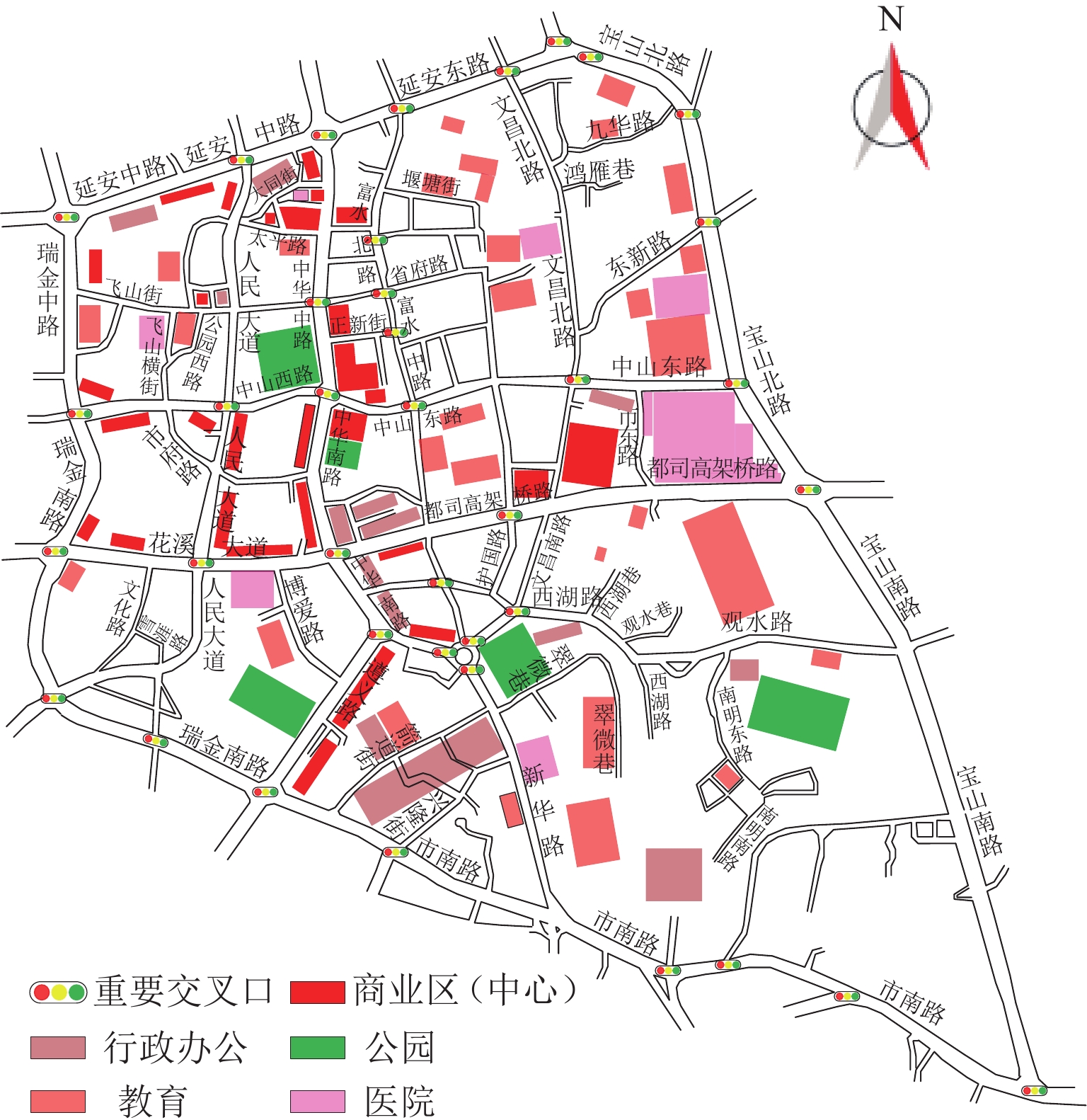
 下载:
下载:
